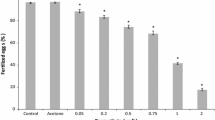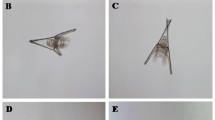Abstract
Presently, a large effort is being made worldwide to increase the sustainability of industrial development, while preserving not only the quality of the environment but also that of animal and human life. In this work, sea urchin early developmental stages were used as a model to test the effects of the organophosphate pesticide (diazinon) on the regulation of gene expression by immunohistochemical localization of the human regulatory protein against the human OTX2. Egg exposure to diazinon did not affect fertilization; however, at concentrations 10−5–10−6 M, it did cause developmental anomalies, among which was the dose-dependent alteration of the intracellular distribution of a regulatory protein that is immunologically related to the human OTX2. The severe anomalies and developmental delay observed after treatment at 10−5 M concentration are indicators of systemic toxicity, while the results after treatment at 10−6 M suggest a specific action of the neurotoxic compound. In this second case, exposure to diazinon caused partial delivery of the protein into the nuclei, a defective translocation that particularly affected the blastula and gastrula stages. Therefore, the possibility that neurotoxic agents such as organophosphates may damage embryonic development is taken into account. Specifically, the compounds are known to alter cytoplasmic dynamics, which play a crucial role in regulating the distribution of intracellular structures and molecules, as well as transcription factors. Speculatively, basing our assumptions on Fura2 experiments, we submit the hypothesis that this effect may be due to altered calcium dynamics, which in turn alter cytoskeleton dynamics: the asters, in fact, appear strongly positive to the OTX2 immunoreaction, in both control and exposed samples. Coimmunoprecipitation experiments seem to supply evidence to the hypothesis.








Similar content being viewed by others
Abbreviations
- ACh:
-
acetylcholine
- AChE:
-
acetylcholinesterase, EC: 3.1.1.7
- BChE:
-
butyrylcholinesterase, EC: 3.1.1.8
- [Ca+]I:
-
intracellular calcium concentration
- dzn:
-
diazinon
- IR:
-
immunoreactivity
- OP:
-
organophosphate compounds (esthers of the pyrophosphoric acid) in the literature, these compounds are also erroneously called organophosphorous compounds
- Otx:
-
regulatory protein of the Otx gene
- OTX2:
-
human regulatory protein of the orthodenticle homolog 2 (Drosophila), paired homeobox, bicoid family
- PMCs:
-
primary mesenchyme cells, represented by micromeres performing the first ingression into the blastocoele, at the beginning of gastrulation
- PMSF:
-
Phenylmethylsulfonyl fluoride
- Siamois:
-
the gene responsible for the specification of dorsal mesoderm
- WGA:
-
wheat germ agglutinin
References
Acampora D, Avvantaggiato V, Tuorto F, Briata P, Corte G, Simeone A. Visceral endoderm-restricted translation of Otx1 mediates recovery of Otx2 requirements for specification of anterior neural plate and normal gastrulation. Development 1998;125(24):5091–104.
Aluigi MG, Angelini C, Falugi C, Fossa R, Genever P, Gallus L, et al. Interaction between organophosphate compounds and cholinergic functions during development. Chem Biol Interact 2005;157–158:305–16.
Angelini C, Costa M, Morescalchi F, Cimoli G, Coniglio L, Falugi C. Muscarinic drugs affect cholinesterase activity and development of eye structures during early chick development. Eur J Histochem 1998;42:309–20.
Burke RD, Angerer LM, Elphick MR, Humphrey GW, Yaguchi S, Kiyama T, et al. A genomic view of the sea urchin nervous system. Dev Biol 2006;300(1):434–60.
Buznikov GA, Shmukler YB, Lauder JM. From oocyte to neuron: do neurotransmitters function in the same way throughout development? Cell Mol Neurobiol 1997;16(5):533–59.
Buznikov GA, Nikitina LA, Bezuglov VV, Lauder JM, Padilla S, Slotkin TA. An invertebrate model of the developmental neurotoxicity of insecticides: effects of chlorpyrifos and dieldrin in sea urchin embryos and larvae. Environ Health Perspect 2001;109(7):651–61.
Buznikov GA, Nikitina LA, Rakic LM, Milosevic I, Bezuglov VV, Lauder JM, et al. The sea urchin embryo, an invertebrate model for mammalian developmental neurotoxicity, reveals multiple neurotransmitter mechanisms for effects of chlorpyrifos: Therapeutic interventions and a comparison with the monoamine depleter, reserpine. Brain Res Bull 2007;74(4):221–31.
Casida JE, Quistad GB. Organophosphate toxicology: safety aspects of nonacetylcholinesterase secondary targets. Chem Res Toxicol 2004;17:983–98.
Chuang C-K, Wikramanayake AH, Mao C-A, Li X, Klein WH. Transient appearance of Strongylocentrotus purpuratus Otx in micromere nuclei: cytoplasmic retention of SpOtx possibly mediated through an α-actinin interaction. Dev Genet 1996;19:231–7.
Corsetti MT, Briata P, Sanseverino L, Daga A, Airoldi I, Simeone A, et al. Differential binding properties of three human homeodomain proteins. Nucleic Acids Res 1992;20:4465–72.
DeSimone DW, Spiegel M. Wheat germ agglutinin binds to the micromeres and primary mesenchyme cells of sea urchin embryos. Dev Biol 1986;114:336–46.
Drews U. Cholinesterase in embryonic development. Prog Histochem Cytochem 1975;7:1–52.
Falugi C. Localization and possible role of molecules associated with the cholinergic system during “non nervous” developmental events. Eur J Histochem 1993;37(4):287–94.
Falugi C, Prestipino G. Effects of some inhibitors on the cholinergic system active during the sea urchin Paracentrotus lividus development. In: Boudouresque CF, editor. Colloque International sur Paracentrotus lividus. Marseilles: Gis Posidonie publ; 1987. p. 147–55.
Falugi C, Pieroni M, Drews U, Stengel P, Lammerding-Koppel M. Possible functions of the “embryonic” cholinergic system present in gametes at fertilization. In: Scalera Liaci L, Canicattì C, editors. Echinoderm research. Rotterdam: Balkema press; 1992. p. 161–4.
Finkelstein R, Boncinelli E. From fly head to mammalian forebrain: the story of otd and Otx. Trends Genet 1994;10:310–5.
Fluck RA, Winshaw-Boris AJ, Schneider LM. Cholinergic molecules modify the in vitro behaviour of cells from early embryos of the medaka Oryzias latipes, a teleost fish. Comp Biochem Physiol 1980;67(C):29–34.
Grifman M, Galyam N, Seidman S, Soreq H. Functional redundancy of acetylcholinesterase and neuroglin in mammalian neuritogenesis. Proc Natl Acad Sci U S A 1998;95(neurobiol):13935–40.
Harrison PK, Falugi C, Angelini C, Whitaker MJ. Muscarinic signalling affects intracellular calcium concentration during the first cell cycle of sea urchin embryos. Cell Calcium 2002;31(6):289–97.
Kiyama T, Zhang N, Dayal S, Yun Lee P, Liang S, Villinski JT, et al. Strongylocentrotus purpuratus transcription factor GATA-E binds to and represses transcription at an Otx-Goosecoid cis-regulatory element within the aboral ectoderm-specific spec2a enhancer. Dev Biol 2005;280(2):436–47.
Li X, Chuang C-K, Mao C-A, Angerer LM, Klein WH. Two Otx proteins generated from multiple transcripts of a single gene in Strongylocentrotus purpuratus. Dev Biol 1997;187:253–66.
Li X, Wikramanayake AH, Klein WH. Requirement of SpOtx in cell fate decisions in the sea urchin embryo and possible role as a mediator of beta-catenin signaling. Dev Biol 1999;212(2):425–39.
Mallamaci A, Di Blas E, Briata P, Boncinelli E, Corte G. Otx homeoprotein in a developing central nervous system and migratory cells of the olfactory area. Mech Dev 1996;58:165–78.
Massoulié J, Pezzementi L, Bon S, Krejici E, Vallette FM. Molecular and cellular biology of cholinesterases. Prog Neurobiol 1993;41:41–91.
Morale A, Coniglio L, Angelini C, Cimoli G, Bolla A, Alleteo D, et al. Biological effects of a neurotoxic pesticide at low concentration early development. A terathogenic assay. Chemosphere 1998;37:3001–10.
Pesando D, Huitorel P, Dolcini V, Angelini C, Guidetti P, Falugi C. Biological targets of neurotoxic pesticides analysed by alteration of developmental events in the Mediterranean sea urchin, Paracentrotus lividus. Mar Environ Res 2003;55(1):39–57.
Quiao D, Nikitina LA, Buznikov GA, Lauder JM, Seidler FJ, Slotkin TA. The sea urchin embryo as a model for mammalian developmental neurotoxicity: ontogenesis of the high-affinity choline transporter and its role in cholinergic trophic activity. Environ Health Perspect 2003;111(14):1730–5.
Romero P, Barnett PG, Midtling JE. Congenital anomalies associated with maternal exposure to oxydemeton-methyl. Environ Res 1989;50:256–61.
Soreq H, Zakut H. Amplification of butyrylcholinesterase and acetylcholinesterase genes in normal and tumor tissues: putative relationship to organophosphorous poisoning. Pharm Res 1990;7(1):1–7.
Sultatos LG. Mammalian toxicology of organophosphorous pesticides. J Toxicol Environ Health 1994;43:271–89.
Swann K, Whitaker MJ. The part played by inositol triphosphate and calcium in the propagation of the fertilization wave in sea urchin eggs. J Cell Biol 1986;103:2333–42.
Watson S, Arkinstall S. The G-protein linked receptor facts book. London: Academic Press Limited, Hartcourt Brace; 1994. p. 8–17.
Yazaki I, Tosti E, Dale B. Cytoskeletal elements link calcium channel activity and the cell cycle in early sea urchin embryos. Development 1995;121:1827–31.
Acknowledgments
We warmly thank Dr. Mario Mori (University of Genova) for continuous supply of living P. lividus specimens in optimal reproductive conditions and Dr. William H. Klein (M. D. Anderson Cancer Center, Houston, TX) for the gift of the anti-SpOtx-β antibody. We also thank Prof. Michael J. Whitaker and Dr. Patrick K. Harrison for their hospitality in the Laboratory of Newcastle upon Tyne University and help in performing the Fura2 experiments.
Author information
Authors and Affiliations
Corresponding author
Additional information
Authors listed in alphabetical order.
Rights and permissions
About this article
Cite this article
Aluigi, M.G., Angelini, C., Corte, G. et al. The sea urchin, Paracentrotus lividus, embryo as a “bioethical” model for neurodevelopmental toxicity testing. Cell Biol Toxicol 24, 587–601 (2008). https://doi.org/10.1007/s10565-008-9061-2
Received:
Accepted:
Published:
Issue Date:
DOI: https://doi.org/10.1007/s10565-008-9061-2




